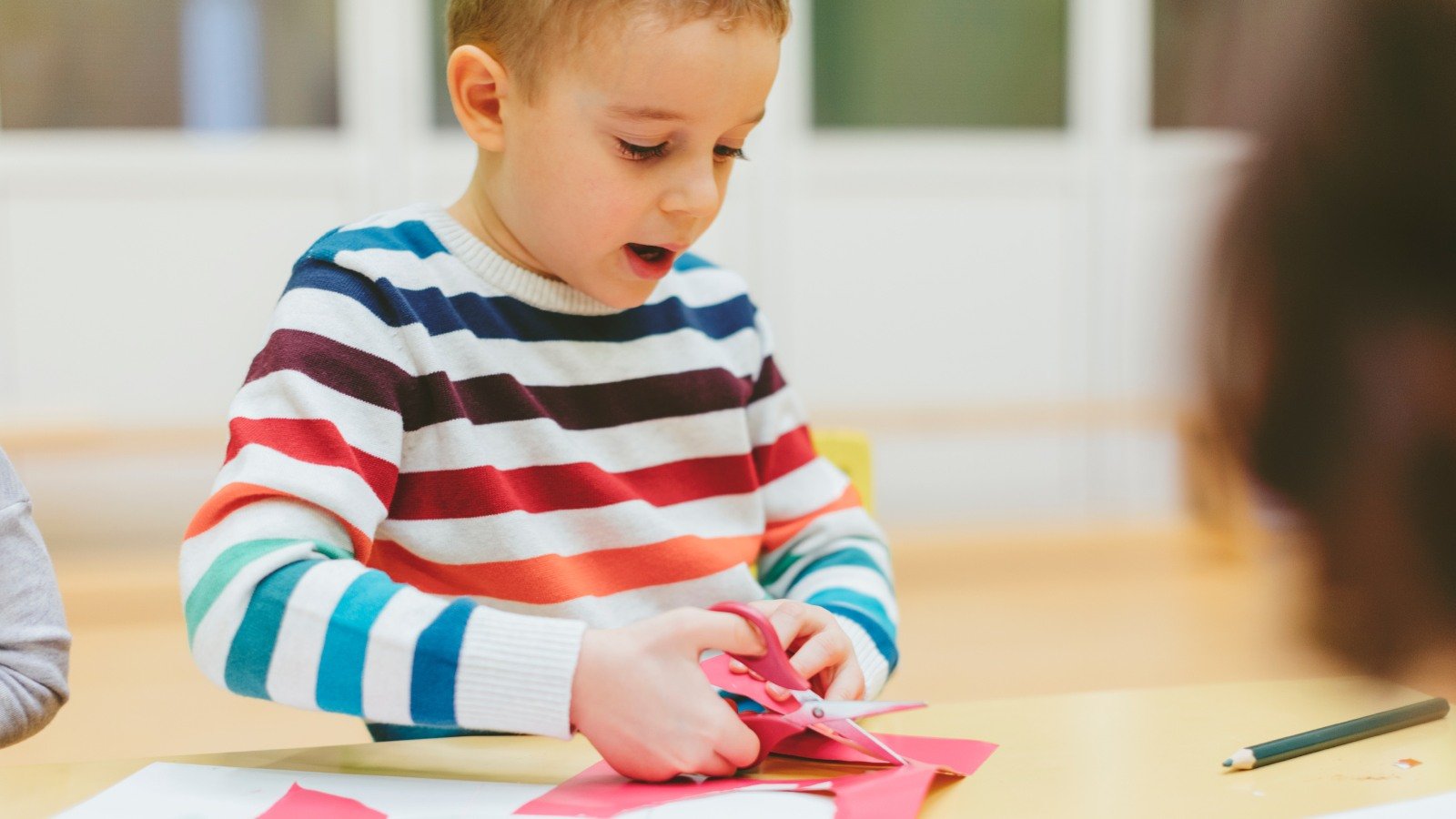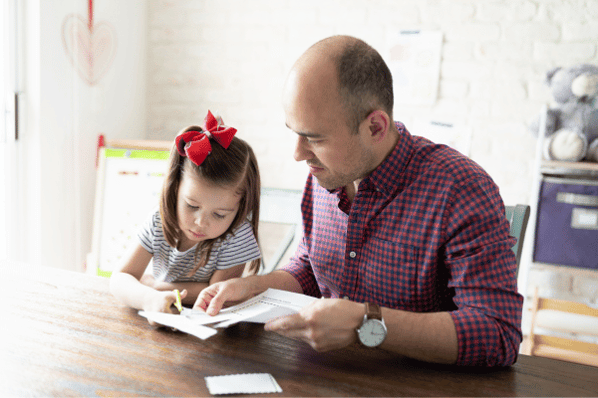
Learning to use scissors can be a tricky skill for children to master. Nonetheless, cutting skills are crucial for children’s development, helping to refine fine motor skills, hand-eye coordination, and visual perception skills.
Using scissors correctly takes time and practice to develop, but there are plenty of safe and simple ways to introduce safe cutting activities to young children. This guide below covers fun, safe, and affordable cutting activities for preschoolers, as well as tips on how to teach scissor skills.
What are scissor skills?
Scissor skills are defined as the ability to hold, open and close, and use scissors to cut objects like paper and play dough. Children develop their cutting skills by learning how to hold a pair of scissors, snip a piece of paper, use a helping hand to hold the paper while cutting, and cut straight lines. Their cutting skills advance when they begin to cut more complex shapes like circles, squares, triangles, and rectangles.
Children are often ready to use scissors by age three. However, this skill isn't completely developed until around age six. However, each child’s development is unique and skills develop at their own pace, so some children might learn this skill earlier or later.
Skills needed for cutting with scissors
You can tell a child is ready to use scissors when:
- They have proper sitting balance. This allows them to use their hands and arms hassle-free.
- Their hand and wrist muscles are more robust and fully developed to hold scissors.
- They can use the thumb, index finger, and middle finger separately without involving the ring and little finger.
- They’ve developed their dominant and assistant hand. The dominant or preferred hand holds the scissors while the assistant hand holds and turns the paper.
- They have proper hand and eye coordination.
- They develop an interest in playing with scissors or watching older children play with scissors.
Scissor skills developmental milestones
Preschoolers typically begin developing scissors skills between 18 months and two years old and can last until around age six. Below are the activities that take place in each developmental stage:
- 18 months to 2 years: Children learn to hold scissors with both hands.
- 2 to 3 years: Children learn to open scissor blades using both hands. The preferred hand is not yet developed, but they can snip paper with the help of an adult.
- 3 to 4 years: Most children start to develop a preference for one hand over the other by age three. Around this age, children are usually able to cut a 10 cm piece of paper into two unequal parts.
- 4 to 5 years: Children begin to cut around corners and curves. They are also able to use their supporting hand to aid the cutting.
- 5 to 6 years: Cutting skills are often fully developed around six years old. Children can cut along curved lines and can also cut out shape varieties like squares, triangles, circles, and ovals.
Why are scissor skills so important?
Scissor skills are important for children’s fine motor skills development, particularly their hand and finger movements. As children develop skills like an increased muscular control of the hand and concentration needed to make precise finger movements, they become more adept at correctly holding and using scissors. Below we explore more reasons why cutting skills are important for children's development.
Supports fine motor skills development
The open and close motion of scissor cutting allows children to use and develop their hand muscles and improve control over their fingers and hands. Children rely on these muscles to perform a diverse range of activities like eating, dressing, drawing, and writing.
Fosters bilateral coordination
Bilateral coordination is the ability to use both sides of the body simultaneously in a controlled manner. Proper bilateral coordination indicates that both sides of a child's brain communicate and work effectively. Preschoolers can improve their bilateral coordination by learning scissors skills since one hand is holding the scissors while the other hand holds the paper or item they are cutting.
Promotes hand-eye coordination
Hand-eye coordination is the ability to use both hands and eyes to perform tasks simultaneously. It involves using the eyes for body awareness and sending signals to the brain to initiate movement.
Children require proper hand-eye coordination skills to perform tasks like writing, buttoning, lacing, or drawing. Scissor cutting helps to foster this coordination as both hands and eyes are working in unison to complete the task.
Improves concentration
Children tend to have shorter attention spans than adults and their concentration skills are still developing. Even simple cutting activities like learning how to hold scissors correctly or cutting in a straight line, all require concentration. Repeated practice with these types of activities can help improve this important skill.
Develops visual perception skills
Visual perception skills refer to the ability to interpret information that is seen and give it meaning. Cutting along lines and curves and cutting out different shapes all help develop children's visual perception skills as they need to be able to distinguish the shapes they are cutting.
Reduce your administrative tasks and enhance children's learning with a childcare management software like brightwheel. Automate daily tasks such as billing and enrollment and increase family engagement with seamless communication and custom progress reports.
How to teach scissor skills
Teaching children scissors skills can be fun as you show them how to experiment with different objects and scissors. Below are some ways you can teach scissors skills.
Demonstrate how to hold scissors
First, you should introduce children to scissors by explaining what they are used for. Depending on their age, some children may already be familiar with scissors but may not know how to hold them correctly.
It's important to show them how to hold scissors before experimenting with different cutting materials.
- Step 1: Give scissors to both right and left-handed children.
- Step 2: Demonstrate how the thumb first goes through the smaller hole in the handles.
- Step 3: Demonstrate how the index and middle fingers go through the larger hole in the handles.
- Step 4: Show them how to operate the scissors by moving the thumb up and down.
Use safety scissors or training scissors
Safety or training scissors typically have blunt tips and edges. They're the perfect fit for preschoolers learning to use scissors for the first time. They have kid-safe blades, so teachers and caregivers don't have to worry about accidents.
Put the skill to the test
Demonstrating how to hold scissors isn’t enough. The goal is to get children to hold the scissors and use them to cut materials. It’s important that you hand the scissors over to the child and help them position their hands correctly.
Use the smiley face thumbnail trick
The smiley face thumbnail trick is an excellent way to motivate children to hold scissors and use them correctly. It works since it encourages the thumb to remain in the right position when cutting. Get a smiley face sticker and stick it on the child’s thumb, telling them that they must always see the smiley face as they cut.
Alternatively, you can use a marker to draw a smiley face on the thumb. Lastly, give the child a pair of scissors, and a piece of paper and let them cut the paper. Their thumb must remain in the right position—slightly pointing up—while opening and closing the scissors.
Share scissor safety tips
Safety is critical, especially when using sharp-bladed scissors. It’s important to share scissor safety tips to avoid any accidents. Here’s a quick rundown of some scissor safety tips to consider:
- Keep your focus on the task at hand.
- Cut in the opposite direction, away from the body.
- Don’t try to catch falling scissors.
- Don’t run while carrying scissors.
- Pass the scissors handle-first to another person.
- Alert an adult immediately if you suffer a scissor injury.
Try different activities to improve pre-scissor skills
Incorporating fun, hands-related activities strengthen children's hand muscles and prepare them for holding and using scissors. Playing with hand puppets and opening and closing their mouths mimics a similar movement of opening and closing scissors. Finger rhymes and finger games help to stabilize hand muscles and strengthen the fingers to hold scissors correctly.
Safe cutting activities for preschoolers
Scissor-cutting is fun and has tons of benefits for children. While simply cutting a piece of paper is sometimes the best activity to introduce cutting skills, we’ve compiled a list of other safe and easy cutting activities for preschoolers for added inspiration:
Cutting grass
Cutting grass is a fun activity for preschoolers. Children can indulge in this activity indoors and outdoors with adult supervision. You'll need safety scissors, a lawn or garden with grass, or grass grown in a box or pot.
Cutting straws
Grab some brightly colored plastic straws and a pair of scissors for this activity. This is a great way to practice cutting items other than paper. Children can cut the straws in half or cut them into smaller pieces.
Cutting flowers
You can have children cut real flowers outdoors in your garden or fake flowers in a sensory bin. You may consider outdoors for this activity if you want the children to be more active. You can provide flowers or let them cut wildflowers outside.
Cutting sensory bin
A cutting sensory bin is a quick and easy way to promote scissor-cutting skills. You'll need a container, pieces of ribbon or paper, and scissors to get started. Fill the container with the paper or ribbon pieces and have children cut them up into smaller pieces.
Cutting play dough
For this activity, you’ll need a tray, play dough, and scissors. Special play dough scissors or blunt-edged scissors are the best for this exercise. Have children roll out or flatten pieces of play dough and then practice their scissor skills. Cutting play dough is an excellent way for children to get used to using scissors as play dough is less flimsy than paper and will stay in place as children cut into it.
FAQs: scissor skills development
How can I help preschoolers improve their scissors skills?
Scissor skills are an important developmental milestone for preschoolers as they contribute to fine motor coordination and enhance hand-eye coordination. As teachers, there are several strategies to implement to help children improve their scissor skills.
First, providing child-friendly safety scissors with rounded tips ensures a safe learning environment. Introducing scissor-themed activities, such as cutting play dough or paper strips, allows children to practice cutting in a fun and engaging way. Additionally, offering proper guidance and modeling correct scissor grasp and technique helps preschoolers develop the right habits from the start.
At what age is a child able to use scissors?
Children can start using scissors between 18 months and two years old. However, their scissor skills don't fully develop until around age six.
What are the best safety precautions for scissors?
Supervise your preschoolers whenever they are using scissors and start with safety scissors or training scissors with blunt-edged tips and blades when learning to hold and cut for the first time.
You can also teach children to practice general scissor safety like keeping their hands away from the edge of the cutting blades, cutting in a direction away from the body, and always passing scissors handle-first to another person.
Final thoughts
Cutting activities improve children's fine motor skills, hand-eye coordination, and concentration skills. By providing child-friendly safety scissors, engaging in scissor-themed activities, and offering proper guidance, teachers can create a supportive learning environment where preschoolers can confidently explore and refine their scissor skills.
As children master this essential skill, they not only gain independence in tasks like arts and crafts but also lay a foundation for future writing and drawing abilities. With simple materials and plenty of practice, your children will feel confident using scissors in no time.
Brightwheel is the complete solution for early education providers, enabling you to streamline your center’s operations and build a stand-out reputation. Brightwheel connects the most critical aspects of running your center—including sign in and out, parent communications, tuition billing, and licensing and compliance—in one easy-to-use tool, along with providing best-in-class customer support and coaching. Brightwheel is trusted by thousands of early education centers and millions of parents. Learn more at mybrightwheel.com.


